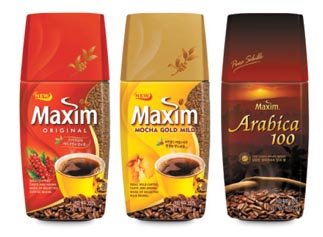Bringing freeze-dried java to masses

Maxim
The company was able to make and market the brand here via a joint venture with U.S.-based General Foods, which is now Kraft Foods.
Management, however, was ready to turn the page and open a new chapter in the company’s history by developing a higher-quality product.
Executives decided to focus on lyophilized - or freeze-dried - coffee, which would be frozen at about -40 degrees Celsius (-40 Fahrenheit) during the manufacturing process and then ground up, helping to lock in freshness.
The idea was to develop java with a better taste and aroma than existing instant coffee. But there was a significant hurdle: the equipment to make the new coffee cost 10 times more than the existing machines. The company also faced opposition from its partner General Foods, which feared that the relatively small coffee market in Korea wouldn’t be able to support the new product.
But Dongsuh executives, who started market research for the product in 1977, were confident that the coffee industry in Korea would expand beyond the realm of coffee shops and into ordinary homes. Their argument was apparently convincing, as General Foods eventually came on board.
General Foods sent a group of engineers from the U.S. to set up a manufacturing facility and provide the technology to develop freeze-dried coffee. Dongsuh, however, wasn’t able to produce a satisfying product after three months of tests on the new machines, and the U.S. technicians left. But Dongsuh continued to work on the machines and discovered that there was a problem in the pumps that mixed extracted coffee and air.
After modifying the pumps, the company was able to produce coffee that met its expectations. Hence, Maxim - Korea’s first freeze-dried coffee - was born. The product was introduced to the market in October 1980 and quickly became a hit.
It continues to be popular today. According to Nelson Data, Maxim currently controls 70 percent of the freeze-dried coffee market in Korea. Along the way, the company has introduced several new types of instant coffees and other java products under the Maxim name, further strengthening its hold on the market.
By Choi Ji-young [ebusiness@joongang.co.kr]










with the Korea JoongAng Daily
To write comments, please log in to one of the accounts.
Standards Board Policy (0/250자)